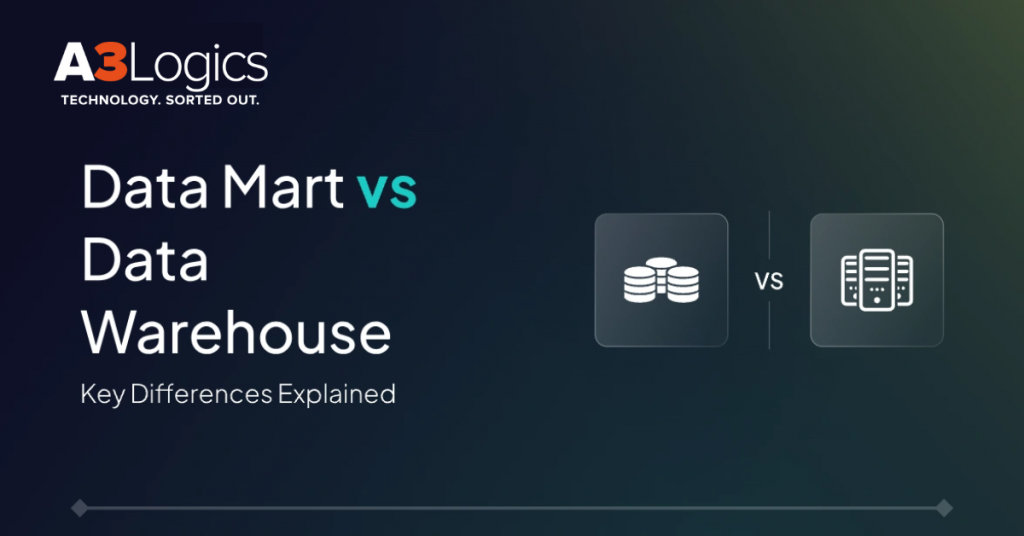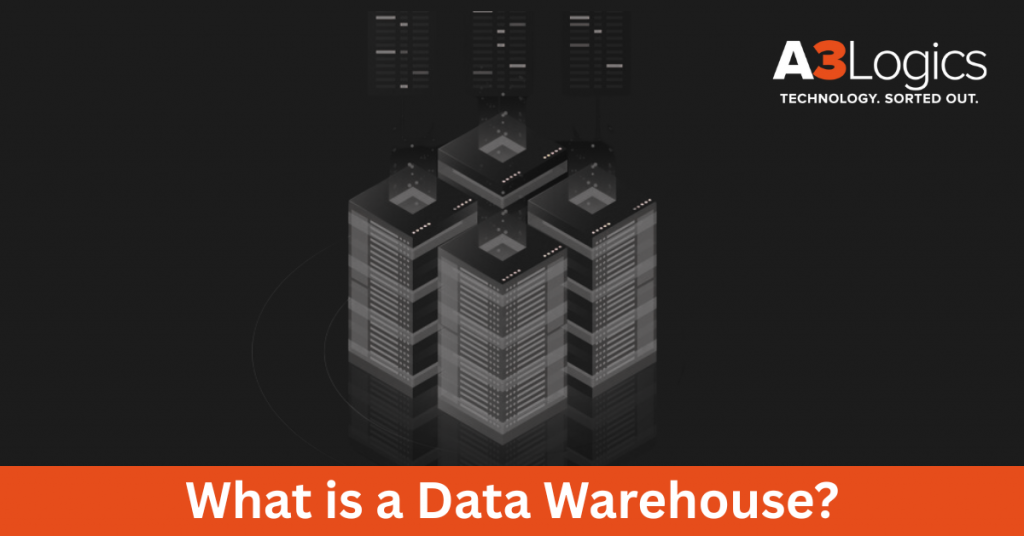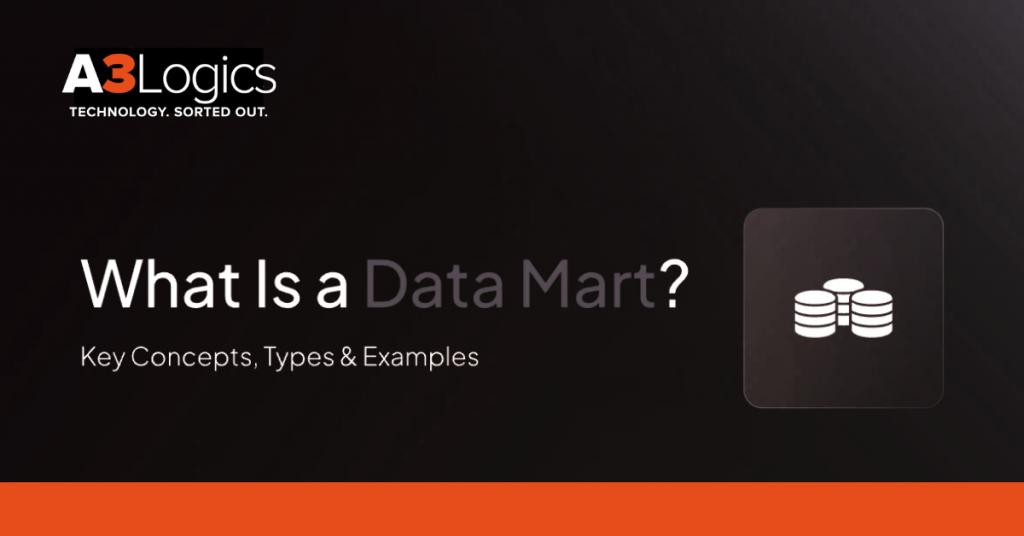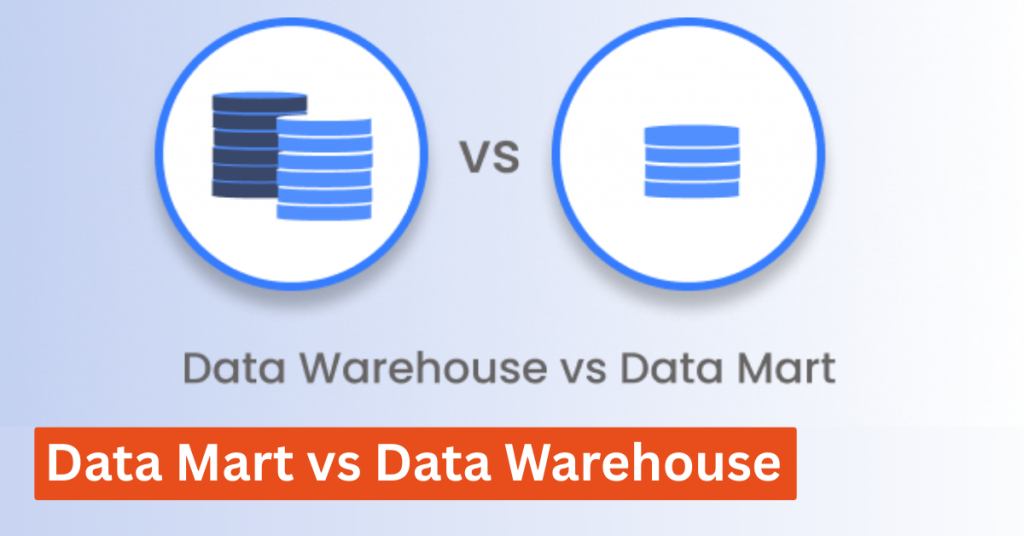Data Mart vs Data Warehouse: Data is a cornerstone for every business as its strategic decisions depend on the valuable insights derived from internal and external environments. Organizations run on structured information and leverage digital solutions to harness analytical capabilities and pilot innovations to stay ahead in the competitive market.

According to recent estimates, more than 400 million terabytes of data are produced daily, and data warehouses and data marts are two pivotal components of the business information landscape. Both terms share similarities and distinct attributes to cater to the varying operational needs of a company.
To understand data mart vs data warehouse systems deeply, let’s dig into what characteristics both the tools hold and what criteria to consider while choosing a suitable solution for your business out of these two options.
Table of Contents
What is a Data Warehouse?
A data warehouse is a centralized platform where all the records aggregated from different domains of an organization are stored. Here, a large volume of data is deposited in structured and semi-structured form, collected from multiple sources. It is a central business information hub that consolidates, transforms, and accesses the saved data for querying and reporting. Warehousing solutions empower companies to integrate scattered information in one place that is easily accessible and facilitates actionable insights.

A proper and resourceful data warehouse architecture comprises systematic extraction, transformation, and loading processes. For example, in e-commerce, a unified data storage platform may collect records and figures from sales transactions, buyer feedback, and website interactions, providing valuable insights into market trends and customer behavior.
The one-stop storage system enables a single source of truth by breaking down the data silos, and eliminating inconsistencies, giving the business united supervision over its information flow at different levels. Let’s understand “what is a data warehouse” along with its key characteristics:
- A data warehouse comprehensively stores historical and current data from different departments of an organization while ensuring consistency and reliability.
- Offer correlation between the collected information and help in trend analysis over extended periods.
- Integrating insights across diverse domains provides an instant response to complex queries. For instance, product details from one system are combined with purchase order records from another system to inform about upcoming stock requirements.
- It facilitates enterprise-wide business intelligence by overseeing the major sectors, including financial, operational, marketing, etc.
What is a Data Mart?
A specific subset of a data warehouse is called a data mart, or it is a small part of the organization-wide records storage system. A DWH is a centralized platform, and a data mart is a more focused system made for a specific purpose. It aims to attend a particular department, function, or user group within a business unit. Distinct sectors can work independently by accessing, abstracting, and analyzing the relevant insights from their subsequent data mart.

The targeted repository system is designed according to the unique needs of different parts of an organization so that they can get their applicable information without searching through the whole data warehouse. It makes the entire process of extracting and exploring analytical details quicker, fostering selective decision-making. Since a data mart only serves an individual business line, it aggregates data only from a particular source.
A company can establish an enterprise-wide data warehouse and then divide it into multiple distinct marts to fulfill the unique needs of every department. Alternatively, they can first build several data marts for their different branches based on their size and requirements, and later, they can construct a single data warehouse by combining the individual parts.
These analytical subsystems store filtered, properly cleaned, optimized, and structured information to provide valuable insights into discrete business operations such as finance, sales, marketing, or human resources. The understanding of “what is a data mart” becomes easier with the explanation of the three types of data marts-
- Dependent data marts are created by obtaining information directly from the existing centralized repository systems, and thus, they depend on the data warehouse for consistency and governance.
- Independent data marts operate autonomously and collect content directly from an organization’s internal and external sources. Enterprises without a unified platform typically use these types of small data hubs as their departmental solutions.
- Hybrid Data Marts combine the two types of targeted systems mentioned above and draw information from the central warehouse as well as other sources. They allow the business to have a governed and standardized subset while maintaining flexibility.
Key Differences Between Data Mart and Data Warehouse
Data mart vs data warehouse is a sophisticated concept highlighting the similar purpose of both systems in the context of enterprise information, while possessing different scopes, usage, structures, and implementations. Organizations looking for an optimal data repository infrastructure must correctly understand the key differences between both terms to tailor them to business goals.

The main differentiating attributes of a Data mart vs data warehouse are as follows:
> Scope and size
A DWH is an extensive centralized repository system that aggregates vast volumes of analytical content often greater than 100 GB, from multiple internal and external sources. its multi-layer scope makes it large in size and generally covers all departmental areas within an organization.
In contrast, a data mart is smaller in size containing less than 100 GB of data. It primarily serves only a specific functional areas like finance or marketing. Its focused approach provides only relevant information with fast and easy data availability.
> Purpose and audience
Data warehouse aims to facilitate enterprise level strategic decision making for the top most authorities and leaders such as administrative executives, managers, researchers, data scientists, and business executives. DWH enable a company wide prospective regarding organizational operations, deriving in-depth reporting, checking compliance , and forecasting analytics.
On the other hand, data marts handle more plotted and departmental-level decision-making, serving ground-level staff and unit teams. A particular manager might use these metrics to draw records or statistics relevant to their division and act accordingly.
> Architecture and design
The fundamental architecture and design of both systems reflect their complexity and scope. Data warehouses feature an intricate framework that includes an extract, transform, and load pipeline, data modeling, staging levels, and governance layers. Their infrastructure is designed to accommodate high performance, scalability, security, and organization-wide use, making the design tricky.
Alternatively, data marts are often simple in design and focused on a single work unit, making their construction easy. They can work independently through their stand-alone system or depend on the existing data warehouse for information sources. With quicker deployment, these repository hubs are less complex and easier to manage.
> Data sources and complexity
The origin and variety of information in these two platforms differ significantly, creating diversity in the required data sources. On one side, the data warehouse includes multiple and large dimensions from heterogeneous references for its strategic input. It generally draws insights from CRM, web applications, spreadsheets, ERP systems, and third-party APIs. Disparate data origin makes the extraction, cleaning, and transformation of records a hectic and extensive task that demands consistency and usability across the business.
On the other hand, a data mart uses only relevant departmental information from homogeneous sources. The facts and figures collected for the individual storage system mostly come directly from the data warehouse itself or a particular application, like Salesforce, for sales data.
> Implementation time and cost
A data warehouse is a resource-intensive platform that requires notable capital investment, time, and other means of commitment. The broad scope and technical complexity require huge funds and staff allocation from initial deployment to full implementation, taking several months to complete the building process.
However, data marts are more cost-effective and less time-consuming, requiring only dedicated staff related to the concerned department. They can be built within weeks and fulfill the needs of a starting point for businesses looking to develop an organization-wide data warehouse.
> Summary Table
Let’s have a glance at the key differences between a data mart vs data warehouse-
| Criteria | Data warehouse | Data mart |
| Scope | Enterprise-wide | Department-specific |
| Audience | Executives, Data Scientists, Analysts | Departmental Analysts, Manager |
| Architecture | Complex, Layered | Simple, Focused |
| Data Sourcing | Multiple, Heterogeneous | Few, Homogeneous |
| Implementation Time | Longer (Months) | Shorter (Weeker) |
| Cost | Higher Investments | Lower Initial Cost |

Use Cases: Data Mart vs Data Warehouse
Data warehouse v/s. Data mart is a crucial debate under modern data architecture, serving distinct organizational goals and departmental needs. Businesses use these two platforms for their respective analytical requirements, so
let’s explore their effective individual use cases as described below:
> Use Cases of Data Warehouse
This unified repository solution caters to enterprise-wide data needs and is ideal for large-scale analytics. With its long-lasting business intelligence capabilities, it enables historical analysis, strategic decision-making, and advanced modeling. Here are the main use cases of data warehouses prominent across the industries-
1. Historical Trend Analysis
Companies commonly count on data warehouses to extract information over multiple years to track and analyze historical trends regarding product demand, market ups and down, cyclic sales variations, or customer feedback over the years. Past insights enable decision makers to learn from previous performance and predict future outcomes while confidently making new strategies.
2. BI Reporting & Dashboards
Organizations use their central repository to generate BI reports and build interactive dashboards. Data warehouses are generally combined with business intelligence tools to visualize key performance indicators, quickly access real-time operational insights, and monitor performance without searching the raw datasets. DWH offers integrated and consistent reporting.
3. Advanced Analytics
An integrated data environment provides enterprises with advanced analytics capabilities, featuring modern techniques such as machine learning, data mining, AI-driven insights, and predictive modeling. This approach requires a well-structured information store that can supply massive volumes of clean and accurate data.
4. Regulatory Compliance & Auditing
There are strict regulatory compliances in numerous industries, including healthcare, telecommunication, and finance. These industries are highly vulnerable to the integrity, consistency, and accuracy of data. A data warehouse supports saving unchangeable, timestamped records that serve an organization’s compliance requirements with regulatory authorities, including HIPAA, SOX, and GDPR. It also assists in time audits by enhancing accurate historical logs and traceability.
5. Customer Relationship Management
A DWH helps in monitoring customer interaction, preferences, and behavior, to make the required changes in customized marketing strategies, targeted sales initiatives, and segmentation. A data warehouse works collaboratively with touchpoints from the CRM system, marketing programs, and support tickets to achieve this capability. The real-world use cases of a data warehouse within an organization help them to redesign their customer relationship management activities.
6. Data Mining and Machine Learning
Wise businesses use their DWH as a data mining and machine learning foundation. They analyze patterns, train ML models, and identify anomalies by consolidating and processing data through warehouses. This unified information hub serves consistent, clean, and high-volume datasets that help in performing customer segmentation, building predictive models, fraud detection, and other advanced analytics. Companies of any size can use the data warehouse to uncover deeper insights from the business environment.
> Use Cases of Data Mart
Even though DMs are smaller and costly than data warehouses, they still contribute significantly to the information repository landscape by delivering quick and specialized insights for faster query performance. Thus, these focused structures are often preferred over centralized frameworks, specifically for departmental analytics. The basic use cases of a data mart are as follows:
1. In Sales and Marketing
Data mart offers highly useful details about sales conversion rates, territorial performance, marketing campaign impacts, and customer distribution. This knowledge enables the sales and marketing professionals to deploy dynamic strategy adjustments and steer data-driven decisions that contribute in revenue creation. The targeted storage system optimizes and tracks market analytics, benefiting the organization in trend analysis and market behavior.
2. Financial Analytics
Enable the finance department to leverage individual data marts to gather monetary information like revenue, profitability, expenses, and financial ratios. The economic department uses this system for variance analysis, budgeting, forecasting, and expense monitoring. These key financial indicators enable the decision-makers to track operating costs and profit margins and ensure fiscal discipline without investigating the massive company-wide database.
3. Human Resources Analytics
HR data marts provide information regarding human resources, such as employee data, performance metrics, workforce trends, attrition analysis, compensation benchmarking, and talent management. Managers can get a lot of useful insights into employee productivity, recruitment efficiency, training and development programs, engagement information, staff demographics, and performance analysis.
This information assists the HR leaders by enabling them to tailor workforce strategies with organizational goals, ultimately accelerating employee retention and satisfaction.
4. Supply Chain Analytics
Smooth logistics is the backbone of a business’s trading activities. The distribution department uses these targeted data hubs to monitor inventory turnover, procurement efficiency, vendor performance, delivery timelines, and the supply chain process. These valuable updates help the organization reduce waste, strengthen logistic operations, identify demand patterns, and maintain an optimum level of stocks.
5. Customer Analytics
Enable the CRM branch to inquire customer preferences, buying behavior, and product satisfaction. Marketing and after-sales services department consolidates buyer-focused analytics across distinct dimensions, including sales, marketing, and customer services. Businesses analyze this strategic content to locate cross-selling and up-selling opportunities and improve customer retention by personalizing customer experiences.
6. Risk and Compliance Analytics
Risk and compliance managers use data marts to keep an eye over key risk indicators, policy adherence, and audit results. The DMs supports the organization in analyzing and reducing legal struggles by fulfilling regulatory requirements. It tailors the sector vise activities with internal official policies and external standards, detects potential fraud, and conducts risk assessments.
Benefits of Data Warehouse and Data Mart
In the current technology-driven landscape, organizations always look for digital solutions to convert their data into insights. Here, the services of a data warehouse and data mart come into play, which help users centralize their scattered information from discrete sources.
No matter what you choose between data mart vs data warehouse, both systems have their different purposes and offer numerous benefits that bring better outcomes.
> Benefits of Data Warehouse
A data warehouse intricately filters information in structured formats drawn from multiple internal and external sources and provides substantial advantages. Let’s have a glance at some core benefits of data warehouses-
1. Centralized Data Repository
The core convenience of adopting DWH is to supply a single source of information. After cleaning, it aggregates the discrete truths from several dimensions and consolidates them in one system. A unified platform eliminates data silos and empowers the leaders with a cross-functional view of all records.
2. Interoperability Between On-premises & Cloud Apps
Advanced data warehouses support a hybrid approach and help merge on-premises and cloud-based frameworks, allowing business flexibility. This enables the organization to adopt modern solutions without dislocating existing architecture, increasing accuracy and efficiency.
3. Enhanced Data Accessibility
DWH is a central information hub throughout the organization, providing unified access to required data for all departments. It also contains robust querying and indexing mechanisms, enabling users to retrieve insights quickly. Lastly, the integrated data across various sectors allows decision-makers to establish up-to-date business intelligence.
4. Improved Data Quality & Consistency
These repository platforms clean, validate, and structure the data gathered from different sources before storing it in the system. This removes duplication, inconsistency, and errors from the content, improving accuracy and reliability, which is crucial during audits.
5. Historical Data Analysis
Data warehouses store historical data over the years and can maintain it for the long term, enabling organizations to perform past trend analysis. They empower leaders to predict the future through strategic forecasting, identify extended growth patterns, and perform performance benchmarking.
6. Support for Complex Analytics and Business Intelligence
DWH makes it easier to access real-time updates within an organization through the extraction, transformation, and loading (ETL) process. It supports advanced analytics such as online analytical processing (OLAP), predictive modeling, and data mining. Companies can generate detailed dashboards, run complex simulations, and assist machine learning/ artificial intelligence initiatives.
> Benefits of Data Mart
Unlike data warehouses, marts offer targeted advantages for unique business needs and individual departments, making them a significant component of the agile information landscape. Here are the main benefits of a data mart that businesses can leverage-
1. Improved Query Performance
As data marts carry only small data sets and targeted information, they offer quick responses to queries. Faster access to insights is crucial for departments like marketing and finance, where real-time decisions are to be made to grab instant opportunities and face unpredictable threats.
2. Cost-Effectiveness
Data marts’ design and architecture are small and simple, offering cost savings without compromising the information needs of various departments. Their maintenance is also less expensive, and small-scale businesses can easily build this targeted subset without investing in an enterprise-wide system.
3. Ensure Data Integrity
A focused repository platform reduces the data validation and transformation complexity by contracting the warehouse to only targeted sectors. It reduces data redundancy and errors due to large volumes of information inconsistencies, providing more trustworthy insights within the department.
4. Enhanced Data Accessibility
Businesses can access a specific unit’s relevant datasets without relying on the entire warehouse platform. The continuous availability of updated insights speeds up strategic decision-making and improves each section’s productivity.
5. Increased Flexibility
Departments can easily build, modify, and preserve data marts while tailoring them to the evolving information needs of businesses from time to time. Organizations can customize their analytical tools to match their specific requirements, such as evaluating supplier efficiency in operations and tracking campaign performance in marketing.

Common Challenges in Managing Data Mart vs Data Warehouse
Both centralized and targeted data repository systems have their share of challenges in development and implementation. However, an understanding of these challenges empowers the business to reduce risks and enhance performance.
> Data Mart Challenges
The most common data mart challenges are, but not limited to:
1. Limitations in Scalability and Integration
A data mart handles specific data related to any particular section of the organization. However, when it comes to managing information across enterprises, the targeted solution is not optimal due to its limited scalability. Individual marts increase data silos contributing to inconsistency in the records. Additionally, integrating multiple data marts is complex, resulting in isolated insights and one-sided versions of the truth.
2. Performance and Data Quality Issues
If the analytical subsystem’s infrastructure is weak, it may become overcrowded with queries, lowering data quality. Also, it may not compile with the standardized data quality protocols, resulting in outdated entries, discrepancies, and poor query performance. Centralized governance is a must to overcome the data quality issue.
3. Cost Considerations and Complexity
A targeted repository system serves only one particular department, and thus, multiple sets for different departments need to be built, increasing the cost and complexity of the data infrastructure.
4. Resource and Maintenance Requirements
Require continuous monitoring, updation, and maintenance, and dedicate resources for the long-term efficiency of DMs, demanding extensive efforts and funds.
> Data Warehouse Challenges
Due to its huge size and scope, DWH involves management complexities, making its implementation and maintenance a burden on organizations. The following are the main data warehouse challenges that businesses face-
1. Handling Large Data Volumes
Data warehouses are supposed to handle massive amounts of content in structured and semi-structured forms derived from various sources. Growing data ingestion rates make it even harder to manage everything efficiently.
2. Ensuring Data Quality and Governance
A proper data governance framework is essential to ensure information quality and reliability in the warehouses and safeguard them from the risk of inaccurate or non-compliant inputs.
3. Adapting to the Cloud Era
Several businesses are shifting from on-premise to cloud-based warehouses, which invites migration and integration challenges for organizations in the area of data security and compliance.
4. Empowering AI and Advanced Analytics
The real-time processing capabilities and high computational power are the foremost requirements to enable machine learning and AI models. However, legacy architecture with these capabilities is not easily available with every business.
When Should You Use a Data Mart vs Data Warehouse?
In a data warehouse vs data mart comparison, organizations look for many elements before choosing a suitable data storage solution for their business. A breakdown of some of the key components is here:
1. Based on Data Types
- Data Warehouse:
It is appropriate for organizations with a massive volume of data from diverse sources that require the integration of all their content for analytical purposes, such as healthcare and financial institutions.
- Data Mart:
Ideal for particular business departments/sectors requiring data relevant to their functions and for their specific analytical needs.
2. Performance Requirements
- Data Warehouse:
Consider DWH for complex and large-scale queries, as it provides machine learning, advanced analytics, and enterprise-wide Business intelligence reporting.
- Data Mart:
These mini warehouses are best for departmental questions requiring quick response and easy accessibility, such as for marketing and finance teams.
3. Cost Factors
- Data Warehouse:
DWH are resource-intensive and need heavy initial investment due to its expensive architecture. However, businesses seeking throughout insights and long-term governance can cover the cost over time.
- Data Mart:
DMs offer budgeted alternatives for the information depository solutions and are the best option for businesses wanting to start small and then scale up their data infrastructure.
4. Data Volume
- Data Warehouse:
A company using large-scale, whole-venture-wide datasets and storing historical information requires DWH. This integrated platform serves the whole data ecosystem and supports consistency.
- Data Mart:
Its narrow scope is appropriate for the targeted data volumes relevant to specific departmental operations that do not need a huge dedicated platform.
5. Business Decision-Making Needs
- Data Warehouse:
Companies working on extensive analytics, tactical decisions, and future-oriented planning require an integrated data system, which offers the needed solutions.
- Data Mart:
Through the data mart, tactical insights, including campaign effectiveness, department-wise key performance indicators, and quarterly performance reviews, can be obtained.
Partner with A3Logics for Data Warehouse and Data Mart Comparison and Development
Companies need a trustworthy, modular, and scalable data framework to convert their insights into practical intelligence in the fast-paced business environment. At A3Logics, we offer customized data mart and data warehouse services that align with your business goals and ensure long-term value. Our expert team commits to helping you 24/7, from deploying applications to post-launch monitoring. We deliver the following expertise and tailor-made DWH and DM solutions to our clients:
- Whether you are seeking to empower departmental teams or build a centralized repository system, our customized data architecture solutions are designed to meet your unique needs. We appraise your running system, business objectives, statistical hardships, and compliance requirements to decide the best structure for your company.
- A3Logics delivers forefront development and integration services, including data modeling, ETL pipeline, and schema design, from planning to deployment. Our company’s advanced data analytics service and BI readiness deliveries go beyond mere information storage.
- Scalable and secure infrastructure is the core point of our development process. We attach a prime security framework to protect sensitive enterprise data and provide expandable accommodation of growing volumes of information without sacrificing compliance and performance.
- Our job does not end after deployment but continues for further support and optimization to ensure the agility and smooth working of your data warehouse and data mart solutions.
- More reasons to choose A3Logics: 20+ years of IT experience, industry-specific expertise in healthcare, manufacturing, retail, logistics, and finance, and a successful digital transformation and data modernization track record.

Conclusion
Data mart vs data warehouse, both fulfill distinct yet complementary purposes despite having different structures, audiences, scopes, and capabilities. Data warehouses offer centralized data storage solutions, whereas data marts are departmental-specific information depository platforms.
Thus, gaining complete knowledge of their diverse characteristics, associated benefits and challenges, and real-world uses is pivotal to getting a holistic view of suitable options for your enterprise based on its size, data complexity, and analytical requirements. However, an IT expert like A3Logics can develop a robust data infrastructure aligned to your business objectives.





